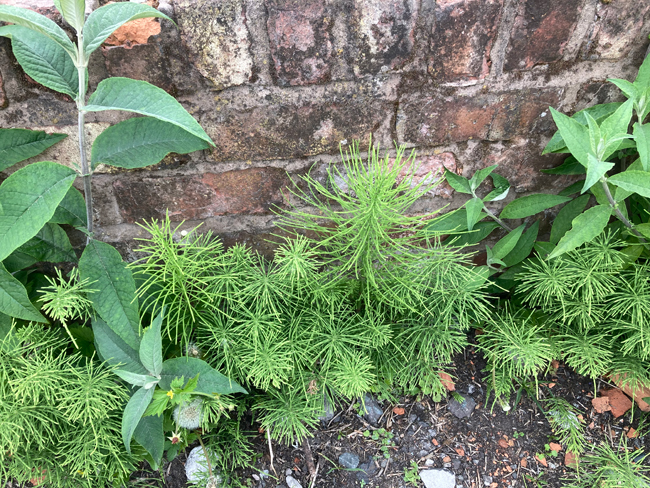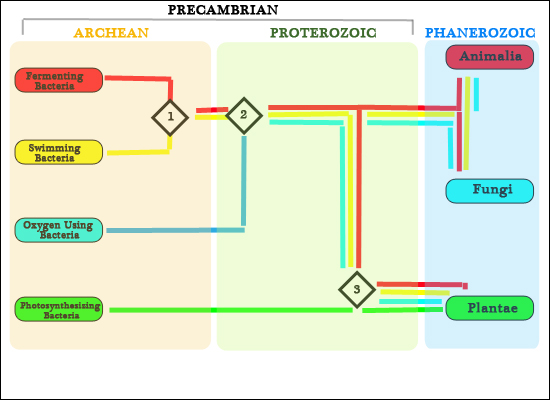The Origin of the Chloroplast
At the centre of most of our planet’s ecosystems are plants and algae that utilise sunlight and transform carbon dioxide and water into carbohydrates and release oxygen. These very specialised organisms can make their own food, by using light energy combined with CO2 and H2O. As part of this process, the water molecule is split and oxygen is produced as a by-product. This process takes place in specialised subunits within a cell called a chloroplast.
Plants and Algae are Fundamental to Most Food Chains on the Planet

Horsetails (Equisetum) continue to thrive as they are able to grow in areas where other plants would find it difficult to get a foothold. Often regarded as weeds, these tough little plants are essentially living fossils as the earliest examples of the genus Equisetum date from the Early Jurassic of South America. New research provides data on the evolution of the chloroplast. Picture credit: Everything Dinosaur.
Picture credit: Everything Dinosaur
The Origin of the Chloroplast
The theory as to how algae and plants evolved goes something like this – an ancient single-celled eukaryote absorbed a photosynthesising bacterium (blue-green algae otherwise known as photosynthesising cyanobacteria). Such an event would normally have been disastrous for both parties, but for some reason, both the eukaryote and the cyanobacteria survived and this led to the development of a symbiotic association. Whilst it is accepted that the cyanobacteria are the ancestors of the chloroplast, it is not clear which of the myriad of cyanobacteria are the closest relations of the chloroplast and when this association began, or indeed where on our planet this fortuitous event took place.
The Evolution of More Complex Life Via the Symbiotic Fusing of Different Kinds of Bacteria
The diagram above shows one theory of how more complex lifeforms evolved. Four different types of bacteria, each with their own specific adaptations and biological characteristics may have merged to create the three main forms of multi-cellular life – animals, plants and fungi.
- Merger 1 – Bacteria with the ability to produce food via fermentation merged with a swimming bacterium.
- Merger 2 – An oxygen utilising bacterium invaded this first host and formed the cell mitochondria.
- Merger 3 – Algae fused with photosynthesising cyanobacteria, which then became the cell chloroplast – the subject of the newly published study.
A Published Scientific Paper
A team of scientists, including researchers from Bristol University, may have found the answers to these questions. Writing in the Proceedings of the National Academy of Sciences, they postulate that the chloroplast lineage split from their closest cyanobacterial ancestor more than 2.1 billion years ago and this took place in low salinity environments. The team conclude that it took another 200 million years for the chloroplast and the eukaryotic host to be fully united into a symbiotic relationship. Marine algae groups diversified much later, at around 800 to 750 million years ago, sometime in the Neoproterozoic Era.
Lead author of the study, Dr Patricia Sanchez-Baracaldo (University of Bristol’s School of Geographical Sciences), commented:
“The results of this study imply that complex organisms such as algae first evolved in freshwater environments, and later colonised marine environments – these results also have huge implications to understanding the carbon cycle. Genomic data and sophisticated evolutionary methods can now be used to draw a more complete picture of early life on land; complementing what has been previously inferred from the fossil record.”
Co-author, Professor Davide Pisani (Bristol University) added:
“Our planet is a beautiful place and it exists in such a sharp contrast with the rest of the solar system. Think about those beautiful satellite pictures where you see the green of the forests and the blue/green tone of the water. Well, Earth was not like that before photosynthesis. Before photosynthesis it was an alien place, uninhabitable by humans. Here we made some big steps to clarify how Earth become the planet we know today, and I think that that is just wonderful.”
Phylogenomic and Bayesian Analytical Methods
The team used a combination of phylogenomic and Bayesian analytical methods to conclude that the chloroplast lineage branched deep within the cyanobacterial tree of life, around 2.1 billion years ago, and ancestral trait reconstruction places this event in low-salinity environments. The chloroplast took another 200 million years to become established, with most extant (modern groups living today), forms originating much later.
Everything Dinosaur acknowledges the assistance of a Bristol University press release in the compilation of this article.
Visit the Everything Dinosaur website: Everything Dinosaur.







Leave A Comment